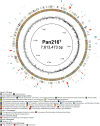Kolteria novifilia, a novel planctomycetotal strain from the volcanic habitat of Panarea divides by unusual lateral budding
- PMID: 40552805
- PMCID: PMC12288469
- DOI: 10.1128/jb.00337-24
Kolteria novifilia, a novel planctomycetotal strain from the volcanic habitat of Panarea divides by unusual lateral budding
Abstract
Members of the phylum Planctomycetota are ubiquitous bacteria that play important roles in the global carbon and nitrogen cycle. In this study, we sampled the shallow-sea hydrothermal vent system close to Panarea Island, Italy, and analyzed the bacterial diversity in this habitat using a cultivation-independent amplicon sequencing approach. Motivated by the observed abundance of members of the phylum Planctomycetota, we employed cultivation conditions that facilitate the enrichment of planctomycetes and isolated strain Pan216T. This strain shows a rarely observed type of cell division-lateral budding. Based on 16S rRNA gene- and multi-locus sequence analyses, its phylogenetic position in the phylum Planctomycetota appears vague. Strain Pan216T clustered between the different described families in the class Planctomycetia. The novel isolate shares the highest sequence identity (85.4%) of the 16S rRNA gene with Thermostilla marina SVX8T, indicating that this strain belongs to a novel family. In addition to its uncommon cell division mode, Pan216T cells are pill-shaped and covered by a putative outer surface layer. Genomic analyses of strain Pan216T revealed many giant genes, putative S-layer protein-encoding genes, and only a limited set of canonical cell division genes. Based on the results of the polyphasic analysis, we conclude that strain Pan216T constitutes a novel family within the phylum Planctomycetota, for which we propose the name Kolteriaceae fam. nov. The novel species Kolteria novifilia gen. nov., sp. nov. is represented by the type strain Pan216T (= DSM 100414T = CECT 9536T).
Importance: We describe a novel family of the underrepresented bacterial phylum Planctomycetota that divides by unusual lateral budding. Our strain is the only validly described species that uses this mode of cell division. Furthermore, it represents the only planctomycete outside of the anammox bacteria that has an S-layer-like structure. Taken together, the novel family shows a novel mechanism of cell division that could only be studied in this species.
Keywords: 16S rRNA; Panarea; V3 region; binary fission; budding; cell division; planctomycetes; surface layer.
Conflict of interest statement
The authors declare no conflict of interest.
Figures






Similar articles
-
Govania unica gen. nov., sp. nov., a rare biosphere bacterium that represents a novel family in the class Alphaproteobacteria.Syst Appl Microbiol. 2023 May;46(3):126405. doi: 10.1016/j.syapm.2023.126405. Epub 2023 Mar 5. Syst Appl Microbiol. 2023. PMID: 36905873
-
Insights into the phylogenetic and metabolic diversity of Planctomycetota in anaerobic digesters and the isolation of novel Thermoguttaceae species.FEMS Microbiol Ecol. 2025 Mar 18;101(4):fiaf025. doi: 10.1093/femsec/fiaf025. FEMS Microbiol Ecol. 2025. PMID: 40097306 Free PMC article.
-
Genomic description of Microbacterium mcarthurae sp. nov., a bacterium collected from the International Space Station that exhibits unique antimicrobial-resistant and virulent phenotype.mSystems. 2025 Jun 17;10(6):e0053725. doi: 10.1128/msystems.00537-25. Epub 2025 May 20. mSystems. 2025. PMID: 40391897 Free PMC article.
-
[Volume and health outcomes: evidence from systematic reviews and from evaluation of Italian hospital data].Epidemiol Prev. 2013 Mar-Jun;37(2-3 Suppl 2):1-100. Epidemiol Prev. 2013. PMID: 23851286 Italian.
-
Fabricating mice and dementia: opening up relations in multi-species research.In: Jenkins N, Jack-Waugh A, Ritchie L, editors. Multi-Species Dementia Studies. Bristol (UK): Bristol University Press; 2025 Feb 25. Chapter 2. In: Jenkins N, Jack-Waugh A, Ritchie L, editors. Multi-Species Dementia Studies. Bristol (UK): Bristol University Press; 2025 Feb 25. Chapter 2. PMID: 40690569 Free Books & Documents. Review.
References
-
- Kallscheuer N, Wurzbacher CE, Schmitz RA, Jogler C. 2024. In the footsteps of Heinz Schlesner and Peter Hirsch: exploring the untapped diversity of the phylum Planctomycetota in isolates from the 1980s to the early 2000s. Syst Appl Microbiol 47:126486. doi: 10.1016/j.syapm.2023.126486 - DOI - PubMed
MeSH terms
Substances
Grants and funding
LinkOut - more resources
Full Text Sources

